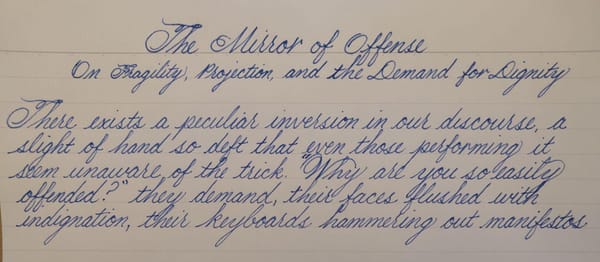Transphobes Play Historian, Part II: The Jung and Restless
The Sequel Nobody Asked For

Bad historical analogies have long been a favorite tool of those opposing civil rights. In a recent Genspect article, tech consultant-turned-religious scholar Daniel Howard James attempted to frame transgender identity as a modern reincarnation of ancient Gnosticism. A historical reach so impressive it would qualify for the Olympic long jump if intellectual gymnastics were a sport.
Now James has returned with a sequel that’s somehow even more convoluted than the original. In “Jung, the Red Book and the Gnostic gospels: Gender as religion, Part two,” James attempts to construct a tenuous connection between Carl Jung’s psychoanalytic theories, ancient Gnostic texts, and modern transgender identity. A comparison that, as we will see, requires so many logical leaps it’s practically parkour. [1]
Let’s dive into this latest exercise in historical revisionism and see what we find when we actually fact-check his claims.
Misrepresenting Jung: A Selective Reading
James begins by suggesting that Jung’s psychoanalytic method provides the foundation for modern transgender identity. This requires some impressive historical cherry-picking and several fundamental misunderstandings of both Jungian psychology and modern gender theory.
Claim #1: Jung’s “Anima/Animus” Theory Validates Transgender Identity
James writes: “‘woman’ literally is a feeling in a man’s head, and vice versa,” suggesting Jung’s theories about the anima (feminine aspects in men) and animus (masculine aspects in women) somehow prefigure or validate transgender identity.
The facts: Jung’s concepts of anima and animus have virtually nothing to do with gender identity as understood today. Jung was describing psychological archetypes that he believed existed in the collective unconscious, not actual gender identity. Jung’s theory was that men and women had unconscious aspects of the opposite gender that influenced their psychology, not that people could literally be a different gender than their assigned sex. [2]
This is a classic example of false equivalence. James is drawing a superficial similarity between two unrelated concepts to suggest they’re fundamentally connected. It’s like claiming vegetarianism is a form of Buddhism because both involve not eating certain animals.
Claim #2: Jung Created a “Spiritual” Practice Similar to Gender Transition
James claims Jung developed a “spiritual, proto-psychoanalytic method based on certain special people unleashing their hidden divinity through self-analysis,” implying modern gender-affirming care follows this model.
The facts: Jung’s psychoanalytic method was indeed more spiritually oriented than Freud’s, but it was focused on psychological integration and individuation and not on validating a specific identity or physical transition. Jung was primarily interested in helping people reconcile contradictory aspects of their psyche, not affirm a specific gender identity. [3]
This represents both cherry-picking (selectively focusing on the spiritual aspects of Jung while ignoring the vast differences in purpose and application) and a false analogy (suggesting that because both involve some form of self-understanding, they must be functionally equivalent).
Mischaracterizing Gender-Affirming Care
Throughout the article, James consistently misrepresents the nature and basis of modern gender-affirming care.
Claim #3: Gender-Affirming Care Has No Scientific Basis
James implies that gender-affirming care is based on “woo” and “psycho-spiritual derangement” rather than scientific evidence.
The facts: Gender-affirming care is supported by decades of peer-reviewed research and endorsed by major medical organizations including the American Medical Association, the American Academy of Pediatrics, and the World Health Organization. These endorsements are based on scientific evidence showing positive outcomes, not mystical beliefs. [4]
A 2022 review in JAMA Pediatrics found that gender-affirming care was associated with 60% lower odds of moderate or severe depression and 73% lower odds of suicidality. [5] This is empirical science, not spiritualism.
This represents a clear straw man fallacy. James is misrepresenting gender-affirming care as based on spiritual belief rather than scientific evidence so it’s easier to dismiss.
Claim #4: The Mental Health System “Affirms Delusions”
James writes: “Based on the manifestation of gender woo over the last decade or more, we might conclude that this method is indeed dangerous for those patients who experience powerful delusions, such as believing they were born in the ‘wrong’ body.”
The facts: Gender dysphoria is not classified as a delusion in any major diagnostic manual. The DSM-5 explicitly distinguishes gender dysphoria from delusional disorders. While James attempts to conflate gender dysphoria with body dysmorphic disorder (BDD), these are recognized as distinct conditions with different clinical presentations, treatments, and outcomes. [6]
This represents an appeal to false authority. James, with no medical credentials, is making clinical claims that directly contradict established diagnostic criteria and scientific consensus.
The Historical Record: Jung and Gender
James attempts to use Jung’s writings to support his claims about gender identity, but his selective quotation misrepresents Jung’s actual views.
Claim #5: Jung Warned Against “Gender Woo”
James quotes Jung: “Gnosticism was also divided into two schools: one school striving after a spirituality that exceeded all bounds, the other losing itself in an ethical anarchism, an absolute libertinism that shrank from no lechery however atrocious and perverse.”
The facts: This quote has nothing to do with gender identity. Jung was discussing historical Gnostic schools and their varying approaches to spirituality and morality. Attempting to apply this to modern transgender identity is a complete non sequitur. Jung never commented on transgender identity as we understand it today. The concept simply wasn’t part of psychological discourse in his era. [7]
This represents a non sequitur fallacy. James is presenting information that has no logical connection to the conclusion being drawn.
James’ Logical Leaps: A Field Guide
Throughout the article, James makes several logical leaps that don’t withstand scrutiny:
Fallacy #1: Guilt by Association
James attempts to discredit gender-affirming care by associating it with Jungianism, Gnosticism, and various spiritual practices. This is a classic guilt by association fallacy, even if there were connections (which there aren’t), the validity of gender-affirming care stands on its own scientific merits.
Fallacy #2: Red Herring
Much of the article focuses on Jung’s personal life, his self-analysis practices, and historical details about Gnostic texts. All of which distract from the actual topic of gender identity and its scientific basis. These are classic red herrings, interesting perhaps, but irrelevant to the validity of transgender identity or gender-affirming care.
Fallacy #3: Slippery Slope
James implies that accepting transgender identity leads to “psycho-spiritual derangement” and people claiming “thine pronouns be god/godself.” This is a slippery slope fallacy, suggesting without evidence that accepting one thing inevitably leads to extreme consequences.
The Reality of Gender Identity Research
What's notably absent from James' article is any engagement with the substantial body of scientific research on gender identity. While James tries to frame gender identity as mystical or religious in nature, modern medicine and psychology understand it through the evidence-based biopsychosocial model—recognizing that biological, psychological, and social factors all interact in complex ways to shape human experience, including gender. [8]
This comprehensive scientific framework includes:
Biological Factors
- Neurobiological studies showing correlations between brain structure and gender identity, including research on the bed nucleus of the stria terminalis and other sexually dimorphic regions [9]
- Genetic research suggesting possible heritable components to gender identity development [10]
- Endocrinological studies examining the complex relationships between hormones and gender development [11]
Psychological Factors
- Longitudinal outcome studies demonstrating the efficacy and positive mental health impacts of gender-affirming care [12]
- Developmental research showing the early emergence and remarkable stability of gender identity in most children [13]
- Clinical studies showing that gender identity is not responsive to conversion efforts, supporting its intrinsic nature [14]
Social Factors
- Cross-cultural research documenting gender diversity across human societies throughout history [15]
- Sociological studies examining how cultural contexts shape the expression and recognition of gender diversity [16]
- Family studies showing the impact of supportive environments on transgender youth outcomes [17]
Integrated Understanding
The biopsychosocial model doesn't treat these factors as separate or competing, but as interdependent elements in a complex system. Unlike James' simplistic framing of gender as either "material" or "spiritual," contemporary science recognizes that multiple factors interacting across development contribute to gender identity formation.
This is why the consensus statements of major medical organizations supporting gender-affirming care are based on a sophisticated integration of evidence across disciplines, not on mystical beliefs or religious doctrine. [18]
Instead of engaging with this substantial body of research, James creates a convoluted narrative about Jung and Gnosticism that bears no relation to how gender identity is actually understood and treated in modern medicine and psychology. By attempting to frame gender identity as essentially religious, James isn't just misrepresenting history—he's ignoring the entire scientific framework that actually informs modern gender-affirming care.
Why This Matters: The Political Strategy at Work
James’ two-part series isn’t really about history, Jung, or Gnosticism - it’s about creating a framework where transgender identity can be dismissed as a belief system rather than recognized as an inherent aspect of human diversity.
This strategy has been used against marginalized groups throughout history:
- During the fight for marriage equality, opponents characterized homosexuality as a “lifestyle choice” rather than an orientation
- Segregationists argued that racial separation was divinely ordained rather than socially constructed
- Women’s suffrage opponents claimed women’s interest in voting was a dangerous new ideology rather than a basic right
In each case, recategorizing an identity as a belief served to justify its exclusion from legal protections and social acceptance.
By framing transgender identity as essentially religious, James attempts to:
- Suggest it can be rejected like any other belief system
- Argue it shouldn’t be “imposed” in secular spaces like schools
- Claim medical care is optional accommodation rather than necessary treatment
- Position anti-transgender views as reasonable skepticism rather than prejudice
This isn’t academic historical analysis. It’s a political strategy with real-world consequences for transgender people’s access to healthcare, education, and basic dignity.
Conclusion: The Final Irony
Perhaps the greatest irony in James’ article is that Jung himself was deeply concerned with authenticity and integration of the self. His concept of individuation was about becoming who you truly are, not conforming to external expectations or repressing aspects of yourself to fit social norms. [11]
If Jung were practicing today, he would likely recognize gender-affirming care as entirely consistent with his therapeutic goals of helping people achieve psychological wholeness and authenticity. What Jung would almost certainly reject is using selective readings of his work to justify denying people the opportunity to live as their authentic selves.
The second irony is that while James frantically tries to frame transgender identity as a religion, he fails to recognize the faith-based system he’s actually practicing: gender critical ideology.
This belief system has all the hallmarks of religious dogma that James claims to critique:
- It requires faith in biological essentialism despite scientific evidence to the contrary
- It has its own sacred texts and authority figures
- It demands adherence to doctrine over observable reality
- It treats inconvenient research findings as heresy
- It even has its own creation myths about how transgender identity supposedly emerged
James concludes his article by quoting journalist Róisín Michaux: “The problem isn’t really that we don’t understand it. It’s that we understand it all too well, but that we won’t politely shut up about it.”
This is perhaps the only accurate statement in the entire piece. The opposition to transgender rights isn’t based on misunderstanding, rather it’s based on understanding exactly what transgender acceptance means for rigid gender norms and choosing to reject it anyway.
What James calls “gender woo” is actually well-established science. What he frames as “religious belief” is actually lived experience validated by research. And what he presents as historical scholarship is actually political advocacy poorly disguised as intellectual inquiry.
So the next time someone tries to tell you that transgender identity is essentially religious in nature, remember: the only faith being practiced is the dogmatic belief that one’s personal discomfort with gender diversity trumps decades of scientific research and the lived experiences of millions of people. And that, unlike gender identity, really is a belief system.
References
[1] James, D. H. (2025, May 24). Jung, the Red Book and the Gnostic gospels: Gender as religion, Part two. Genspect.
https://genspect.substack.com/p/is-gender-a-new-religion-or-a-very-part2
[2] Jung, C. G. (1968). The archetypes and the collective unconscious (2nd ed.). Princeton University Press. https://www.jungiananalysts.org.uk/wp-content/uploads/2018/07/C.-G.-Jung-Collected-Works-Volume-9i_-The-Archetypes-of-the-Collective-Unconscious.pdf
[3] Stein, M. (2006). Jung’s map of the soul: An introduction. Open Court Publishing. https://archive.org/details/jungs-map-of-the-soul-an-introduction-by-murray-stein
[4] Coleman, E., Radix, A. E., Bouman, W. P., Brown, G. R., de Vries, A. L. C., Deutsch, M. B., Ettner, R., Fraser, L., Goodman, M., Green, J., Hancock, A. B., Johnson, T. W., Karasic, D. H., Knudson, G. A., Leibowitz, S. F., Meyer-Bahlburg, H. F. L., Monstrey, S. J., Motmans, J., Nahata, L., … Arcelus, J. (2022). Standards of care for the health of transgender and gender diverse people, version 8. International Journal of Transgender Health, 23(sup1), S1-S259. https://doi.org/10.1080/26895269.2022.2100644
[5] Tordoff, D. M., Wanta, J. W., Collin, A., Stepney, C., Inwards-Breland, D. J., & Ahrens, K. (2022). Mental Health Outcomes in Transgender and Nonbinary Youths Receiving Gender-Affirming Care. JAMA Network Open, 5(2), e220978. https://doi.org/10.1001/jamanetworkopen.2022.0978
[6] American Psychiatric Association. (2022). Diagnostic and Statistical Manual of Mental Disorders (DSM-5-TR). American Psychiatric Publishing. https://www.psychiatry.org/psychiatrists/practice/dsm
[7] Shamdasani, S. (2003). Jung and the making of modern psychology: The dream of a science. Cambridge University Press. https://archive.org/details/jungmakingofmode0000sham
[8] Engel, G. L. (1977). The need for a new medical model: A challenge for biomedicine. Science, 196(4286), 129-136.
[9] Guillamon, A., Junque, C., & Gómez-Gil, E. (2016). A review of the status of brain structure research in transsexualism. Archives of Sexual Behavior, 45(7), 1615-1648. https://pmc.ncbi.nlm.nih.gov/articles/PMC4987404/#Sec28
[10] Polderman, T. J. C., Kreukels, B. P. C., Irwig, M. S., Beach, L., Chan, Y. M., Derks, E. M., Esteva, I., Ehrenfeld, J., Heijer, M. D., Posthuma, D., Raynor, L., Tishelman, A., & Davis, L. K. (2018). The biological contributions to gender identity and gender diversity: Bringing data to the table. Behavior Genetics, 48(2), 95-108.
[11] Saraswat, A., Weinand, J., & Safer, J. (2015). Evidence supporting the biologic nature of gender identity. Endocrine Practice, 21(2), 199-204.
[12] What We Know Project, Cornell University. (2018). What does the scholarly research say about the effect of gender transition on transgender well-being? https://whatweknow.inequality.cornell.edu/topics/lgbt-equality/what-does-the-scholarly-research-say-about-the-well-being-of-transgender-people/
[13] Olson, K. R., Durwood, L., DeMeules, M., & McLaughlin, K. A. (2016). Mental health of transgender children who are supported in their identities. Pediatrics, 137(3), e20153223.
[14] American Psychological Association. (2021). Resolution on gender identity change efforts. https://www.apa.org/about/policy/resolution-gender-identity-change-efforts.pdf
[15] Nanda, S. (2014). Gender diversity: Crosscultural variations (2nd ed.). Waveland Press. https://archive.org/details/genderdiversityc00nand_0
[16] Stryker, S. (2017). Transgender history: The roots of today's revolution (2nd ed.). Seal Press. https://archive.org/details/transgenderhisto0000stry
[17] Travers, R., Bauer, G., & Pyne, J. (2012). Impacts of strong parental support for trans youth: A report prepared for Children's Aid Society of Toronto and Delisle Youth Services. Trans PULSE Project. https://transpulseproject.ca/wp-content/uploads/2012/10/Impacts-of-Strong-Parental-Support-for-Trans-Youth-vFINAL.pdf
[18] American Medical Association. (2023). Health care for transgender and gender diverse individuals. https://transhealthproject.org/resources/medical-organization-statements/american-medical-association-statements/https://archive.org/details/jungpostjungians0000samu


